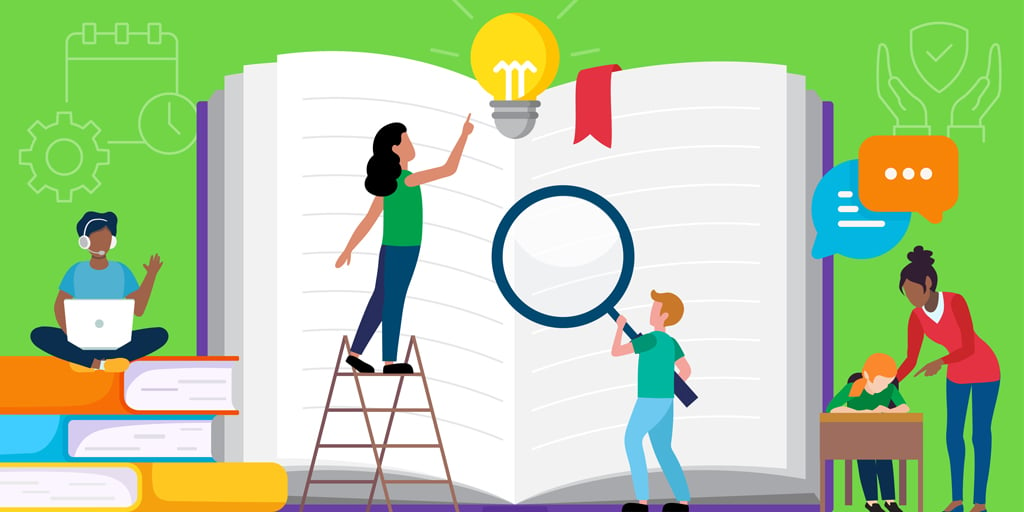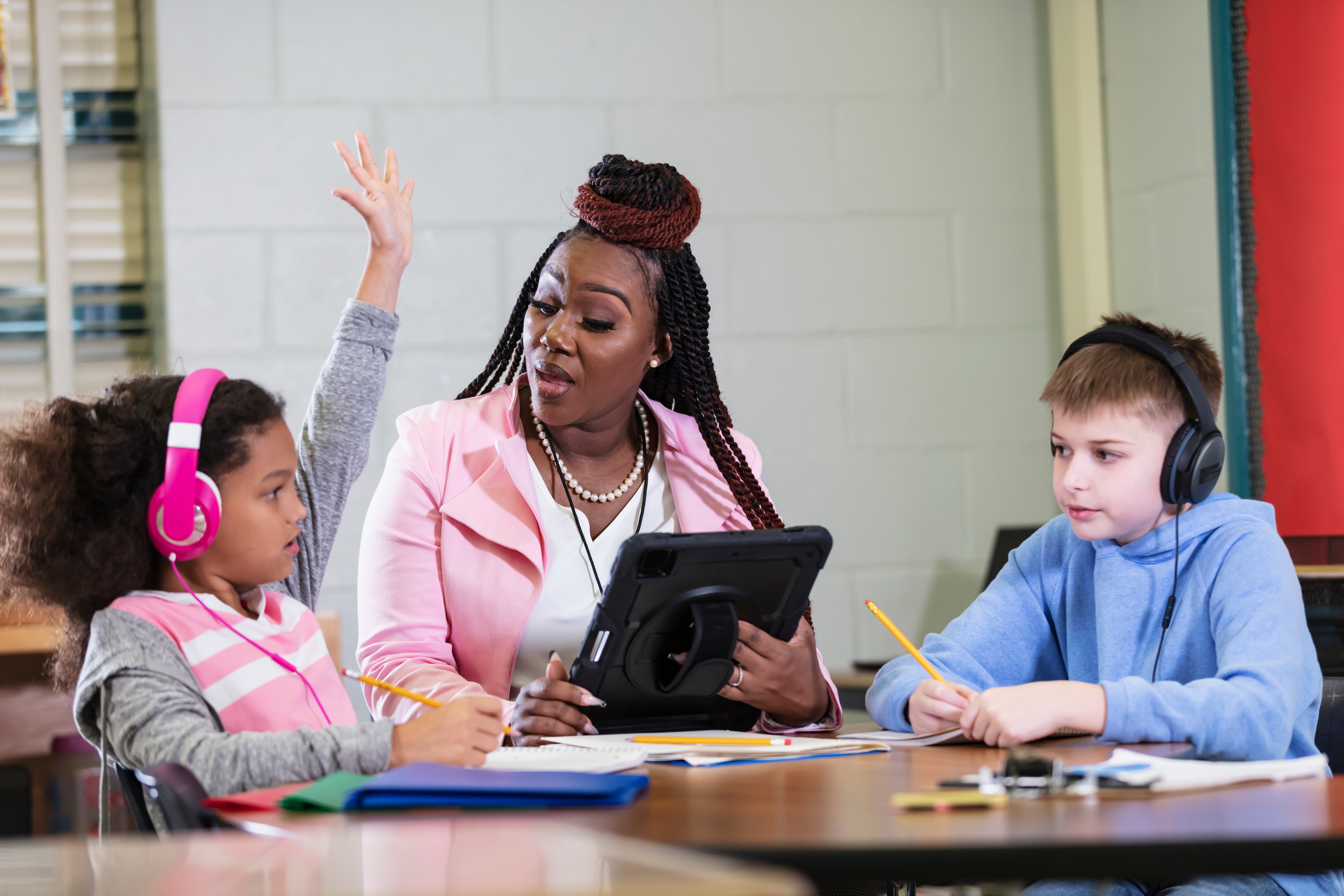Share this
Beyond Silence: Embracing the Dynamic Chaos of Engaged Learning
by Connie Warren on Feb 23, 2024 9:15:00 AM
Chairs scraping, voices overlapping, students darting from corner to corner—chaos? Or the perfect storm of learning in action?

Funny Farm, an 80s movie where Chevy Chase tries to sell his country farm by literally paying off the townspeople. It reminds me of some of the shenanigans I’ve seen (and considered doing) during classroom observation time! We think we want students to be well-behaved during those moments. But what we should really hope for, although much less uniform and tidy, is students who are actively engaged.
True engagement might resemble chaos at first glance, but it's actually a sign of active, deep learning. Engaged students aren't sitting quietly and passively absorbing information; they're moving around, discussing, asking questions, and sometimes even creating a bit of a mess. This dynamic atmosphere, where learning is visibly and audibly interactive, is where students truly understand and apply concepts.
What does student engagement look like?
- Joining the Conversation: When students are engaged, the room is alive with the buzz of discussion as students actively participate, not just answering questions but posing their own, challenging concepts, and adding new perspectives.
- Thirst for Knowledge: In an engaged classroom, students are asking questions that lead to more questions. Their eagerness to learn drives them to push the boundaries of the standard curriculum, turning each lesson into a journey of discovery.
- Trailblazers of Learning: Here, students take the lead in their learning journey. The classroom becomes a launchpad for exploration, with students making connections across different subjects and coming up with innovative solutions.
- Unity in Uniqueness: In a truly engaged classroom, the line between teacher and student blurs as everyone becomes an active participant in the learning process. Students themselves create a dynamic environment where various perspectives are not just welcomed but are integral to the learning experience.
- Reflective Revolutionaries: Students stand out for their ability to think deeply about what they learn. They don't just take in information; they ponder, question, and connect it to broader concepts, leading to a more nuanced understanding of the subject matter.
How can I foster engagement?
To maintain student engagement, educators can employ a variety of strategies that foster an environment conducive to active learning and exploration. Here are some key approaches:
Deep Questioning
Encourage students to go beyond surface-level understanding by posing open-ended questions that require deep thinking.
Encourage Academic Risk
Create a classroom culture where mistakes are viewed as learning opportunities rather than failures.
Student Voice
Critical Thinking
Embrace Oneness
Meaningful Connections
By integrating these strategies into teaching practices, educators can create a dynamic and supportive learning environment that encourages active participation, critical thinking, and a lifelong love of learning.
But what if they "go off on a tangent"?
When students are genuinely interested in a subject, their curiosity can lead them down various paths, exploring related topics and ideas that might not be strictly within the curriculum. This exploration is a sign of deep engagement and critical thinking, as it shows that students are not just passively absorbing information but actively connecting it to other knowledge and their own interests.
In a well-facilitated learning environment, you can help guide these explorations, linking them back to the core subject matter while also validating the students' interests. This approach can help students see the interconnectedness of knowledge and how what they are learning applies to the wider world.

How does engagement differ in virtual learning?
In a digital learning environment, engagement takes on new dimensions, harnessing the power of technology to create an energizing and interactive experience. Here's what it might look like:
- Dynamic Discussions: Online forums and chat rooms buzz with activity, where students eagerly post questions, share insights, and engage in lively debates. The threads become rich tapestries of shared knowledge, with each post adding another layer of depth to the collective understanding.
- Interactive Tools and Resources: Students utilize various digital tools and resources, from interactive simulations to multimedia presentations. These tools transform passive learning into an active exploration, allowing students to manipulate variables, see real-time results, and make learning a hands-on experience.
- Collaborative Projects: Even in a virtual setting, students come together to work on group projects, using shared digital workspaces like Google Docs or collaborative platforms like Trello or Slack. These tools enable real-time collaboration and brainstorming, mirroring the teamwork and interaction of a physical classroom.
- Engaging Multimedia: Video calls replace traditional classroom discussions, bringing faces and voices into each home. This visual and auditory connection helps maintain the human element of learning, making interactions more engaging and personal.
- Gamification and Interactive Assessments: Learning platforms often incorporate gamification elements, such as points, badges, and leaderboards, to make learning more engaging. Interactive quizzes and assessments provide immediate feedback, making learning more dynamic and rewarding.
In the lively, sometimes chaotic world of an engaged classroom, we find the heart of true learning. Far from the silent rows of a traditional setting, this vibrant atmosphere—where questions spark more questions and every student's voice is valued—is where real understanding and curiosity flourish. By embracing this dynamic environment, we can transform their classrooms, both physical and virtual, into hubs of active, deep learning, where every moment is an opportunity for discovery and growth.
Learn More:
Share this
- October 2025 (2)
- September 2025 (1)
- August 2025 (1)
- July 2025 (1)
- June 2025 (1)
- April 2025 (2)
- March 2025 (3)
- January 2025 (3)
- December 2024 (1)
- November 2024 (1)
- October 2024 (4)
- September 2024 (2)
- August 2024 (3)
- July 2024 (2)
- June 2024 (4)
- May 2024 (3)
- April 2024 (4)
- March 2024 (4)
- February 2024 (3)
- January 2024 (5)
- December 2023 (3)
- November 2023 (5)
- October 2023 (5)
- September 2023 (5)
- August 2023 (4)
- July 2023 (5)
- June 2023 (8)
- May 2023 (2)
- April 2023 (3)
- March 2023 (4)
- February 2023 (1)
- January 2023 (1)
- November 2022 (1)
- October 2022 (1)
- September 2022 (1)
- August 2022 (1)
- June 2022 (1)
- April 2021 (1)
- March 2021 (1)
- October 2020 (1)
- December 2019 (1)
- November 2019 (1)
- October 2019 (1)
- July 2019 (1)
- January 2019 (1)
- December 2018 (1)
- October 2018 (1)
- August 2018 (1)
- May 2018 (2)
- April 2018 (1)
- March 2018 (2)
- February 2018 (2)